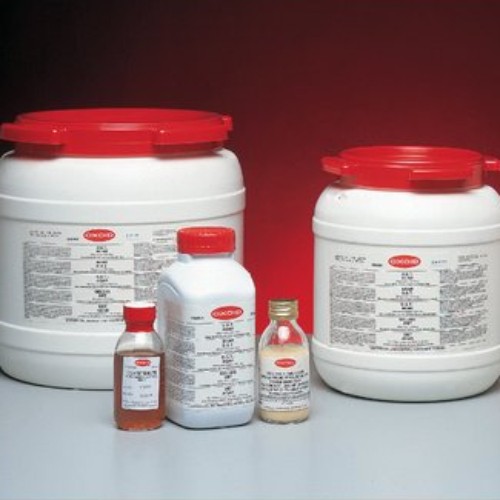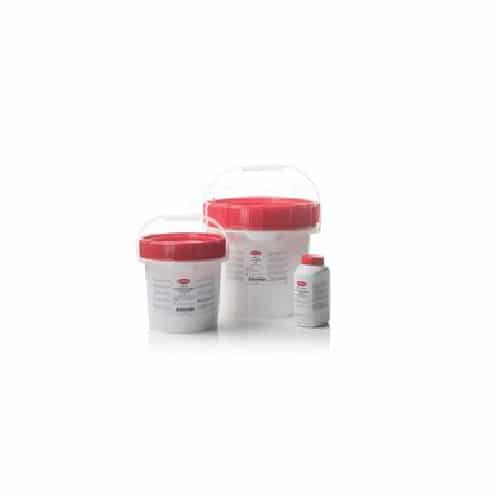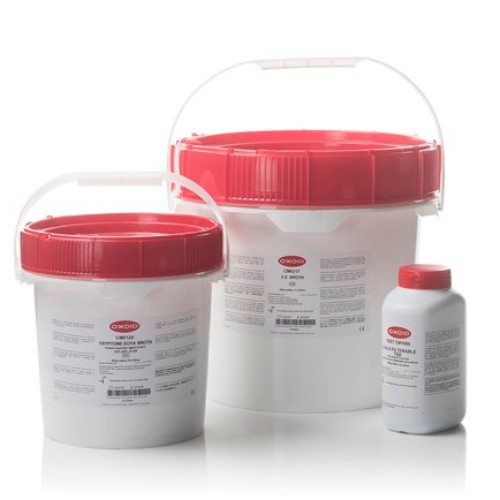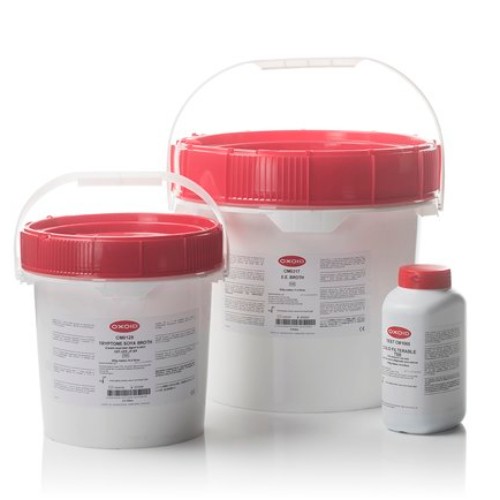
Buffered Peptone Water 500g
Login to see pricesBrand:
Thermo ScientificTM OxoidTM
Buffered Peptone Water (Dehydrated), CM0509B (Oxoid) is a non-selective pre-enrichment medium that used to pre-enrich food samples prior to the isolation of Salmonella species. It also provides conditions for the resuscitation of cells that have been injured by processes of food preservation.
Buffered Peptone Water, Oxoid Composition
| Typical Formula* |
gm/litre |
| Peptone |
10.0 |
| Sodium chloride |
5.0 |
| Disodium phosphate |
3.5 |
| Potassium dihydrogen phosphate |
1.5 |
| pH 7.2 ± 0.2 @ 25°C |
Buffered Peptone Water, Oxoid Preparation:
Add 20g to 1 litre of distilled water. Mix well and distribute into final containers. Sterilise by autoclaving at 121°C for 15 minutes. It is extremely important that the distilled water used is of a high quality with a low mineral content/conductivity.
Storage conditions and Shelf life
Store dehydrated medium at 10-30°C and use before the expiry date of the label.
Store the prepared medium at room temperature.

Mac-Conkey Agar (Without Salt) 500g
Login to see pricesBrand:
Thermo ScientificTM OxoidTM
- Oxoid MacConkey Agar w/o Salt (Dehydrated) is a differential medium on which swarming of Proteus species is suppressed.
- For urine examination.
MacConkey Agar without Salt (Dehydrated), Oxoid Composition
| Typical Formula* |
gm/litre |
| Peptone |
20.0 |
| Lactose |
10.0 |
| Bile salts |
5.0 |
| Neutral red |
0.075 |
| Agar |
12.0 |
| pH 7.4 ± 0.2 @ 25°C |
MacConkey Agar, Oxoid Preparation:
Suspend 47g in 1 litre of distilled water. Bring to the boil to dissolve completely. Sterilise by autoclaving at 121°C for 15 minutes. Mix well before pouring. Dry the surface of the gel before inoculation.
Storage conditions and Shelf life
Store the dehydrated medium at 10-30°C and use before the expiry date on the label.
Store the prepared plates of medium at 2-8°C.
Precautions
The colonial characteristics described give presumptive identification only of the isolated organisms. It is necessary to subculture and carry out confirmation tests for final identification.
To enhance the pigment of suspected Staphylococcus aureus, hold the plates on the bench at ambient temperature for 12-18 hours.
This medium may produce a discrete precipitate on cold storage of 2 – 10°C. This in no way affects the performance of the medium.

MacConkey Broth (Purple) (CM5a) 500g
Login to see pricesBrand:
Thermo ScientificTM OxoidTM
Detect coliform organisms in water and milk examination with Thermo Scientific™ Oxoid™ MacConkey Broth Purple (Dehydrated). Bromocresol purple indicator in the medium provides more sensitive and definite indications of acid production as compared to neutral red indicator and is less inhibitory to Escherichia coli. The use of bromocresol purple corresponds to the alternative formulations recommended in ‘The Bacteriological Examination of Water Supplies’ and ‘International Standard for Drinking Water’.
MacConkey Broth Purple, Oxoid Composition
| Typical Formula* |
gm/litre |
| Peptone |
20.0 |
| Lactose |
10.0 |
| Bile salts |
5.0 |
| Sodium chloride |
5.0 |
| Bromocresol purple |
0.01 |
| pH 7.4 ± 0.2 @ 25°C |
MacConkey Broth Purple, Oxoid Preparation:
To prepare single strength broth add 40g to 1 litre of distilled water. Distribute into containers fitted with fermentation (Durham) tubes. Sterilise by autoclaving at 121°C for 15 minutes.
Storage conditions and Shelf life
Store the dehydrated medium at 10-30°C and use before the expiry date on the label.
Store the prepared medium at room temperature.

Schaedler Broth 500g
Login to see pricesBrand:
Thermo ScientificTM OxoidTM
- Oxoid Schaedler Anaerobe Broth is a thioglycollate-free broth for the general growth of anaerobes.
- For use in blood cultures and antibiotic MIC studies.
Schaedler Anaerobe Broth, Oxoid Composition
| Typical Formula* |
gm/litre |
| Tryptone Soya Broth (Oxoid CM129) |
10.0 |
| Special peptone |
5.0 |
| Yeast extract |
5.0 |
| Glucose |
5.0 |
| Cysteine HCl |
0.4 |
| Haemin |
0.01 |
| Tris Buffer |
0.75 |
| pH 7.6 ± 0.2 @ 25°C |
Schaedler Anaerobe Broth, Oxoid Preparation:
Add 26.5g to 1 litre of distilled water and mix to dissolve completely. Dispense into final containers and sterilise by autoclaving at 121°C for 15 minutes.
Storage conditions and Shelf life
Store the dehydrated medium at 10-30°C and use before the expiry date on the label.
Store prepared broth in the dark at <15°C.
Precautions
As with all anaerobic broth media, it is important to avoid chemo-oxidation (overheating) and photo-oxidation (storage in the light) because such oxidative effects cause the inhibition of growth.

Tinsdale Medium 500g
Login to see pricesBrand:
Thermo ScientificTM OxoidTM
Oxoid Tinsdale Agar Base is used for the isolation and identification of Corynebacterium diphtheriae.
Tinsdale Agar Base, Oxoid Composition
| Typical Formula* |
gm/litre
|
| Proteose peptone |
20.0 |
| Yeast extract |
5.0 |
| Sodium chloride |
5.0 |
| L-cystine |
0.24 |
| Agar |
15.0
|
| pH 7.9 ± 0.2 @ 25°C |
Tinsdale Agar, Oxoid Preparation:
Suspend 9g of agar base in 200ml of distilled water. Bring to the boil and dissolve completely. DO NOT AUTOCLAVE. Allow to cool to approximately 50°C and add the contents of one vial of Oxoid Tinsdale Supplement SR0065 reconstiuted as directed. Mix throughly and pour into sterile Petri dishes.
Storage conditions and Shelf life
Store the dehydrated medium at 10-30°C and use before the expiry date on the label.
Store the prepared medium at 2-8°C for not more than 4 days.
Precautions
Further tests must be carried out on colonies suspected as Corynebacterium diphtheriae, including cell morphology after sub-culture to Loeffler’s Medium and examination for toxin production.
Do not incubate Tinsdale’s Agar plates in enhanced CO2 atmosphere (5-10% v/v).

Violet Red Bile Glucose Agar 500g
Login to see pricesBrand:
Thermo ScientificTM OxoidTM
Detect and enumerate Enterobacteriaceae in food products with Thermo Scientific™ Oxoid™ Violet Red Bile Glucose Agar (Dehydrated). This glucose-containing selective medium gives reproducible counts of typical colonies for food safety analysis. In the examination of food stuffs, detection of the Enterobacteriaceae that ferment glucose to produce acid and/or gas has been recommended.
Violet Red Bile Glucose Agar (Dehydrated), Oxoid Composition
| Typical Formula* |
gm/litre
|
| Yeast extract |
3.0 |
| Peptone |
7.0 |
| Sodium chloride |
5.0 |
| Bile Salts No.3 |
1.5 |
| Glucose |
10.0 |
| Neutral red |
0.03 |
| Crystal violet |
0.002 |
| Agar |
12.0 |
| pH 7.4 ± 0.2 @ 25°C |
Violet Red Bile Glucose Agar (Dehydrated), Oxoid Preparation:
Suspend 38.5g in 1 litre of distilled water. Bring to the boil. Continue to boil for 2 minutes or for the minimum time necessary to dissolve completely and ensure that there are no remaining flecks of unmelted agar. No further sterilisation is necessary or desirable. Mix well and dispense into tubes or dishes.
Storage conditions and Shelf life
Store the dehydrated medium at 10-30°C and use before the expiry date on the label.
Store the prepared medium at 2-8°C and use as freshly as possible.
Precautions
This medium is not completely specific for Enterobacteriaceae, other organisms may grow e.g. Aeromonas. The selective activity of this medium diminishes after 24 hours incubation and organisms previously suppressed may exhibit growth. Medium for the pour-plate procedure should be freshly prepared, cooled to 47°C and used within 3 hours.

Endo Agar Base 500g
Login to see pricesBrand:
Thermo ScientificTM OxoidTM
A modified medium requiring the addition of basic fuchsin to form Endo Agar.
- Oxoid Endo Agar is an APHA recommended medium for the confirmation of coliforms.
- Also available Basic Fuchsin Indicator, Part No. BR0050A.
Endo Agar Base, Oxoid Composition
| Typical Formula* |
gm/litre |
| Peptone |
10.0 |
| Lactose |
10.0 |
| Di-potassium phosphate |
3.5 |
| Sodium sulphite |
2.5 |
| Agar |
10.0 |
| pH 7.5 ± 0.2 @ 25°C |
Endo Agar, Oxoid Preparation:
Suspend 36g in 1 litre of distilled water. Add 6ml (or as directed by the supplier) of a 10% w/v solution of basic fuchsin BR0050 (50:50 ethanol/distilled water). Bring to the boil to dissolve completely. Sterilise by autoclaving at 121°C for 15 minutes. Mix well before pouring. Plates should be stored in the dark to preserve their pale pink colour.
BASIC FUCHSIN IS A POTENTIAL CARCINOGEN AND CARE SHOULD BE TAKEN TO AVOID INHALATION OF THE POWDERED DYE AND CONTAMINATION OF THE SKIN.
Storage conditions and Shelf life
Store the dehydrated medium at 10-30°C and use before the expiry date on the label.
Store the prepared plates at 2-8°C away from light.
Precautions
Weigh out the basic fuchsin (BR0050) in a fume cupboard and avoid inhalation of the powder or contamination of the skin.
Keep the prepared medium away from light to avoid photo-oxidation.
Endo Agar is quoted by the American Public Health Association as a `Standard Methods’ medium for use in water1 and dairy products. Windle Taylor recommended the medium for the isolation and differentiation of coli-aerogenes bacteria from water.

Iso-Sensitest Broth 500g
Login to see pricesBrand:
Thermo ScientificTM OxoidTM
Perform effortless testing using Thermo Scientific™ Oxoid™ Iso-Sensitest Broth (Dehydrated), a semi-defined medium specifically designed for antimicrobial susceptibility testing (AST). Iso-Sensitest Broth is carefully constructed to give reproducible results. It allows the growth of the majority of microorganisms without the need of further supplementation.
Iso-Sensitest Broth, Oxoid Composition
| Typical Formula* |
gm/litre |
| Hydrolysed casein |
11.0 |
| Peptones |
3.0 |
| Glucose |
2.0 |
| Sodium chloride |
3.0 |
| Soluble starch |
1.0 |
| Disodium hydrogen phosphate |
2.0 |
| Sodium acetate |
1.0 |
| Magnesium glycerophosphate |
0.2 |
| Calcium gluconate |
0.1 |
| Cobaltous sulphate |
0.001 |
| Cupric sulphate |
0.001 |
| Zinc sulphate |
0.001 |
| Ferrous sulphate |
0.001 |
| Manganous chloride |
0.002 |
| Menadione |
0.001 |
| Cyanocobalamin |
0.001 |
| L-Cysteine hydrochloride |
0.02 |
| L-Tryptophan |
0.02 |
| Pyridoxine |
0.003 |
| Pantothenate |
0.003 |
| Nicotinamide |
0.003 |
| Biotin |
0.0003 |
| Thiamine |
0.00004 |
| Adenine |
0.01 |
| Guanine |
0.01 |
| Xanthine |
0.01 |
| Uracil |
0.01 |
| pH 7.4 ± 0.2 @ 25°C |
|
Iso-Sensitest Broth, Oxoid Preparation:
Add 23.4g to 1 litre of distilled water. Mix well and heat to dissolve. Distribute into tubes or bottles. Sterilise by autoclaving at 121°C for 15 minutes.
Storage conditions and Shelf life
Store the dehydrated medium at 10-30°C and use before the expiry date on the label.

Iso-Sensitest Agar 500g
Login to see pricesBrand:
Thermo ScientificTM OxoidTM
Thermo Scientific™ Oxoid Iso-Sensitest Agar is a semi-defined medium designed for antimicrobial susceptibility testing.
Iso-Sensitest Agar, Oxoid Composition
| Typical Formula* |
gm/litre |
| Hydrolysed casein |
11.0 |
| Peptones |
3.0 |
| Glucose |
2.0 |
| Sodium chloride |
3.0 |
| Soluble starch |
1.0 |
| Disodium hydrogen phosphate |
2.0 |
| Sodium acetate |
1.0 |
| Magnesium glycerophosphate |
0.2 |
| Calcium gluconate |
0.1 |
| Cobaltous sulphate |
0.001 |
| Cupric sulphate |
0.001 |
| Zinc sulphate |
0.001 |
| Ferrous sulphate |
0.001 |
| Manganous chloride |
0.002 |
| Menadione |
0.001 |
| Cyanocobalamin |
0.001 |
| L-Cysteine hydrochloride |
0.02 |
| L-Tryptophan |
0.02 |
| Pyridoxine |
0.003 |
| Pantothenate |
0.003 |
| Nicotinamide |
0.003 |
| Biotin |
0.0003 |
| Thiamine |
0.00004 |
| Adenine |
0.01 |
| Guanine |
0.01 |
| Xanthine |
0.01 |
| Uracil |
0.01 |
| Agar |
8.0 |
| pH 7.4 ± 0.2 @ 25°C |
Iso-Sensitest Agar, Oxoid Preparation:
Suspend 31.4g in 1 litre of distilled water and bring to the boil to dissolve the agar. Sterilise by autoclaving at 121°C for 15 minutes.
Storage conditions and Shelf life
Store the dehydrated medium at 10-30°C and use before the expiry date on the label.
Store the prepared medium at 2-8° C and use as freshly as possible.

X.L.D. Medium 2.5kg
Login to see pricesBrand:
Thermo ScientificTM OxoidTM
Isolate Salmonella and Shigella from clinical specimens and foods with selective Thermo Scientific™ Oxoid™ XLD Agar (Dehydrated). The medium relies on xylose fermentation, lysine decarboxylation and production of hydrogen sulphide for the primary differentiation of shigellae and salmonellae from non-pathogenic bacteria. The careful addition of sodium desoxycholate inhibits the growth of coliforms without decreasing the ability to support shigellae and salmonellae.
XLD Agar (Dehydrated), Oxoid Composition
| Typical Formula* |
gm/litre |
| Yeast extract |
3.0 |
| L-Lysine HCl |
5.0 |
| Xylose |
3.75 |
| Lactose |
7.5 |
| Sucrose |
7.5 |
| Sodium desoxycholate |
1.0 |
| Sodium chloride |
5.0 |
| Sodium thiosulphate |
6.8 |
| Ferric ammonium citrate |
0.8 |
| Phenol red |
0.08 |
| Agar |
12.5 |
| pH 7.4 ± 0.2 @ 25°C |
XLD Agar (Dehydrated), Oxoid Preparation:
Suspend 53g in 1 litre of distilled water. Heat with frequent agitation until the medium boils. DO NOT OVERHEAT. Transfer immediately to a water bath at 50°C. Pour into sterile Petri dishes as soon as the medium has cooled.
It is important to avoid preparing large volumes which will cause prolonged heating.
Storage conditions and Shelf life
Store the dehydrated medium at 10-30°C and use before the expiry date on the label.
Store the prepared medium at 2-8°C.

X.L.D. Medium 500g
Login to see pricesBrand:
Thermo ScientificTM OxoidTM
Isolate Salmonella and Shigella from clinical specimens and foods with selective Thermo Scientific™ Oxoid™ XLD Agar (Dehydrated). The medium relies on xylose fermentation, lysine decarboxylation and production of hydrogen sulphide for the primary differentiation of shigellae and salmonellae from non-pathogenic bacteria. The careful addition of sodium desoxycholate inhibits the growth of coliforms without decreasing the ability to support shigellae and salmonellae.
XLD Agar (Dehydrated), Oxoid Composition
| Typical Formula* |
gm/litre |
| Yeast extract |
3.0 |
| L-Lysine HCl |
5.0 |
| Xylose |
3.75 |
| Lactose |
7.5 |
| Sucrose |
7.5 |
| Sodium desoxycholate |
1.0 |
| Sodium chloride |
5.0 |
| Sodium thiosulphate |
6.8 |
| Ferric ammonium citrate |
0.8 |
| Phenol red |
0.08 |
| Agar |
12.5 |
| pH 7.4 ± 0.2 @ 25°C |
XLD Agar (Dehydrated), Oxoid Preparation:
Suspend 53g in 1 litre of distilled water. Heat with frequent agitation until the medium boils. DO NOT OVERHEAT. Transfer immediately to a water bath at 50°C. Pour into sterile Petri dishes as soon as the medium has cooled.
It is important to avoid preparing large volumes which will cause prolonged heating.
Storage conditions and Shelf life
Store the dehydrated medium at 10-30°C and use before the expiry date on the label.
Store the prepared medium at 2-8°C.

Standard Plate Count Agar (Apha) 500g
Login to see pricesBrand:
Thermo ScientificTM OxoidTM
Thermo Scientific™ Oxoid Standard Plate Count Agar (Plate Count Agar) is a standard medium corresponding to the APHA formulation used for milk, food and dairy products.
Standard Plate Count Agar (Plate Count Agar), Oxoid Composition
| Typical Formula* |
gm/litre |
| Yeast extract |
2.5 |
| Pancreatic digest of casein |
5.0 |
| Glucose |
1.0 |
| Agar |
15.0 |
| pH 7.0 ± 0.2 @ 25°C |
Standard Plate Count Agar (Plate Count Agar), Oxoid Preparation:
Suspend 23.5g in 1 litre of distilled water. Bring to the boil to dissolve completely. Dispense into bottles and sterilise by autoclaving at 121°C for 15 minutes.
Storage conditions and Shelf life
Store the dehydrated medium at 10-30°C and use before the expiry date on the label.
Store the prepared plates at 2-8°C.

Lauryl Tryptose Broth 500g
Login to see pricesBrand:
Thermo ScientificTM OxoidTM
Detect coliform organisms in water, waste water and dairy products with selective Thermo Scientific™ Oxoid™ Lauryl Tryptose Broth (Dehydrated), while conforming to the formula detailed by American Public Health Association. Lauryl Tryptose Broth is designed to promote a rich growth and copious gas production from small inocula of coliform organisms.
Lauryl Tryptose Broth, Oxoid Composition
| Typical Formula* |
gm/litre |
| Tryptose |
20.0 |
| Lactose |
5.0 |
| Sodium chloride |
5.0 |
| Dipotassium hydrogen phosphate |
2.75 |
| Potassium dihydrogen phosphate |
2.75 |
| Sodium lauryl sulphate |
0.1 |
| pH 6.8 ± 0.2 @ 25°C |
|
Lauryl Tryptose Broth, Oxoid Preparation:
Dissolve 35.6g in 1 litre of distilled water and distribute into containers with fermentation tubes (Durham). Sterilise by autoclaving at 121°C for 15 minutes.
Storage conditions and Shelf life
Store the dehydrated medium at 10-30°C and use before the expiry date on the label.
Store the prepared medium at room temperature.
Precautions
If stored at 2-8°C the broth will become cloudy or form a precipitate. This should clear at room temperature but gas formation is the criterion of growth not turbidity.

Schaedler Agar 500g
Login to see pricesBrand:
Thermo ScientificTM OxoidTM
Grow and isolate aerobic and anaerobic organisms of the intestinal tract, which may require selective conditions to inhibit the growth of background organisms like Escherichia coli, with Thermo Scientific™ Oxoid™ Schaedler Anaerobe Agar. The presence of cysteine in the medium provides selectivity against Escherichia coli as cysteine has shown to have inhibitory effects on several enzymatic reactions of Escherichia coli in vitro.1
Schaedler Anaerobe Agar, Oxoid Composition
| Typical Formula* |
gm/litre |
| Tryptone Soya Broth (Oxoid CM129) |
10.0 |
| Special peptone |
5.0 |
| Yeast extract |
5.0 |
| Glucose |
5.0 |
| Cysteine HCl |
0.4 |
| Haemin |
0.01 |
| Tris Buffer |
0.75 |
| Agar |
13.5 |
| pH 7.6 ± 0.2 @ 25°C |
|
Schaedler Anaerobe Agar, Oxoid Preparation:
Suspend 40g in 1 litre of distilled water and boil to dissolve the medium completely. Sterilise by autoclaving at 121°C for 15 minutes. Mix well before pouring.
Storage conditions and Shelf life
Store the dehydrated medium at 10-30°C and use before the expiry date on the label.
Prepared plates may be stored at 2-8°C if suitably protected.

S I M Medium 500g
Login to see pricesBrand:
Thermo ScientificTM OxoidTM
A medium for the differentiation of enteric bacteria on the basis of sulphide production, indole production and motility.

Amies Transport Medium 250g
Login to see pricesBrand:
Thermo ScientificTM OxoidTM
Oxoid Amies Transport Medium is used for the preservation of microorganisms in transit.

CLED Medium with Andrade Indicator 500g
Login to see pricesBrand:
Thermo ScientificTM OxoidTM
Isolate, enumerate and differentiate urinary pathogens with good colonial differentiation and clear diagnostic characteristics using Thermo Scientific™ Oxoid™ CLED Medium w/Andrade’s Indicator (Dehydrated). The medium is a modification of the CLED Medium as described by Mackey and Sandys1. The addition of Andrade’s indicator along with bromothymol blue in the medium enhances the appearance of colonies and aids in the identification of microorganisms. The electrolyte deficient nature of CLED Medium prevents the swarming of Proteus species thereby further improving the colonial differentiation.

Hektoen Enteric Agar 500g
Login to see pricesBrand:
Thermo ScientificTM OxoidTM
Isolate and differentiate Shigella and Salmonella spp. from enteric pathological specimens with Thermo Scientific™ Oxoid™ Hektoen Enteric Agar (Dehydrated). Hektoen Enteric Agar was developed by King and Metzger. When compared to other selective media this medium gives higher yield of Salmonella and Shigella, while inhibiting accompanying Gram-positive and other microorganisms.
Hektoen Enteric Agar, Oxoid Composition
| Typical Formula* |
gm/litre |
| Proteose peptone |
12.0 |
| Yeast extract |
3.0 |
| Lactose |
12.0 |
| Sucrose |
12.0 |
| Salicin |
2.0 |
| Bile salts No.3 |
9.0 |
| Sodium chloride |
5.0 |
| Sodium thiosulphate |
5.0 |
| Ammonium ferric citrate |
1.5 |
| Acid fuchsin |
0.1 |
| Bromothymol blue |
0.065 |
| Agar |
14.0 |
| pH 7.5 + 0.2 @ 25°C |
|
Hektoen Enteric Agar, Oxoid Preparation:
Suspend 76g of the medium in 1 litre of distilled water and soak for 10 minutes. Heat gently and allow to boil for a few seconds to dissolve the agar. DO NOT AUTOCLAVE. Cool to 50°C and pour plates.
Storage conditions and Shelf life
Store the dehydrated medium at 10-30°C and use before the expiry date on the label.
Store the prepared plates at 2-8°C.
Precautions
Do not overheat the medium or hold it molten for long periods. Proteus species may resemble salmonellae or shigellae.
Further testing must be carried out to confirm the presumptive identification of organisms isolated on this medium.

Sensitest Agar 500g
Login to see pricesBrand:
Thermo ScientificTM OxoidTM
A medium specially designed to give large, clear zones with all antibiotics, without the addition of lysed or whole blood.
Sensitest Agar, Oxoid Composition
| Typical Formula* |
gm/litre |
| Hydrolysed casein |
11.0 |
| Peptones |
3.0 |
| Sodium chloride |
3.0 |
| Glucose |
2.0 |
| Starch |
1.0 |
| Buffer salts |
3.3 |
| Nucleoside bases |
0.02 |
| Thiamine |
0.00002 |
| Agar |
8.0 |
| pH 7.4 ± 0.2 @ 25°C |
Sensitest Agar, Oxoid Preparation:
Suspend 32g in 1 litre of distilled water and bring to the boil to dissolve the agar. Sterilise by autoclaving at 121°C for 15 minutes.
Storage conditions and Shelf life
Store the dehydrated medium at 10-30°C and use before the expiry date on the label.
Store the prepared plates of agar at 2-8°C.
Precautions
As with other susceptibility testing media, Sensitest Agar should be used for rapidly growing aerobic organisms only. It should not be modified by the addition of carbohydrates or incubated in a CO2 enriched atmosphere.
If the medium is used for Bell’s CDS method then the specified discs and technique must be used. Refer to the monograph cited in the References.

Mueller Hinton Agar 500g, Oxoid
Login to see pricesBrand:
Thermo ScientificTM OxoidTM
Perform effortless Antimicrobial Susceptibility Testing (AST) using Thermo Scientific™ Oxoid™ Mueller Hinton Agar (Dehydrated), a medium designed and manufactured according to the European standard, EUCAST and the American standard, CLSI.
Composition of Mueller Hinton Agar, Oxoid
| Typical Formula* |
gm/litre |
| Dehydrated infusion from beef |
300.0 |
| Casein hydrolysate |
17.5 |
| Starch |
1.5 |
| Agar |
17.0 |
| pH 7.3 ± 0.1 @ 25°C |
Preparation of Mueller Hinton Agar, Oxoid
Add 38g of Mueller Hinton Agar to 1 litre of distilled water. Bring to the boil to dissolve the medium completely. Sterilize by autoclaving at 121°C for 15 minutes.
Storage conditions and Shelf life:
Store the dehydrated Mueller Hinton Agar, Oxoid at 10-30°C and use before the expiry date on the label.
Store the prepared Mueller Hinton Agar plates at 2-8°C.
Precautions
Incubation in a carbon dioxide enriched atmosphere is not recommended because of its pH effect on the medium. If it is imperative to use CO2 then known control organisms should be included with the test plates to measure its effect.
Carbohydrates should not be added to Mueller-Hinton Agar because they may influence the rate of growth of the organism and the resulting pH of the medium.
The addition of lysed horse blood to the medium may further reduce the levels of thymidine and prevent the growth of thymidine-dependent organisms.
The medium may not support the growth of some fastidious strains for example microorganisms that require thymine and thymidine for growth. Close adherence to the methodology is required to obtain satisfactory results.

Mueller Hinton Broth 500g, Oxoid
Login to see pricesBrand:
Thermo ScientificTM OxoidTM
Mueller Hinton Broth, Oxoid conforms to international standards for antimicrobial susceptibility testing media.
| Typical Formula* |
gm/litre |
| Dehydrated infusion from Beef |
300.0 |
| Casein hydrolysate |
17.5 |
| Starch |
1.5 |
| pH 7.3 ± 0.1 @ 25°C |
Mueller Hinton Broth, Oxoid Preparation
Place 21.0g of Mueller Hinton Broth, Oxoid in 1 litre of distilled water mix to dissolve completely. Sterilize by autoclaving at 121°C for 15 minutes. Chill and adjust cation levels if necessary.
Storage conditions and Shelf life
Store the dehydrated Mueller Hinton broth at 10-30°C and use before the expiry date on the label.
Store the prepared Mueller Hinton broth at 2-8°C.
Precautions
Monitor the performance of the broth routinely using the standard QC organisms. If the broth does not yield the expected MIC values, modify the volumes of Mg++ and Ca++ solutions.
If the thymidine content is lowered, after the addition of lysed horse blood or thymidine phosphorylase, the MIC values may be lower.

Mycoplasma Broth Base 500g
Login to see pricesBrand:
Thermo ScientificTM OxoidTM
- Oxoid Mycoplasma Broth Base is used for the selective isolation of Mycoplasma species.
- Also available Mycoplasma Supplement G, Part No. SR0059C.
Mycoplasma Broth Base, Oxoid Composition
| Typical Formula* |
gm/litre |
| Bacteriological peptone |
10.0 |
| Lab-Lemco’ powder |
10.0 |
| Sodium chloride |
5.0 |
| Mineral supplement |
0.5 |
| pH 7.8 ± 0.2 @ 25°C |
|
Mycoplasma Broth, Oxoid Preparation:
Dissolve 25.5g in 1 litre of distilled water. Mix well and distribute in 80ml volumes. Sterilise by autoclaving at 121°C for 15 minutes. Cool to approximately 50°C and add one vial of Mycoplasma Supplement SR0059 reconstituted as directed.
Storage conditions and Shelf life
Store the dehydrated medium at 10-30°C and use before the expiry date on the label.
Store the prepared medium at 2-8°C.
Precautions
Thallous acetate is toxic, observe the precautions stated under Hazards section..
Sub-culture the broth to agar as soon as any indicator added begins to change colour before the pH change destroys the organism.

Mycoplasma Agar Base 500g
Login to see pricesBrand:
Thermo ScientificTM OxoidTM
- Oxoid Mycoplasma Agar Base is used for the selective isolation of Mycoplasma pneumoniae.
- Also available Mycoplasma Supplement P, Part No. SR0060C and Mycoplasma Supplement G, Part No. SR0059C.
Mycoplasma Agar Base, Oxoid Composition
| Typical Formula* |
gm/litre |
| Bacteriological peptone |
10.0 |
| `Lab-Lemco’ powder |
10.0 |
| Sodium chloride |
5.0 |
| Mineral supplement |
0.5 |
| Agar |
10.0 |
| pH 7.8 ± 0.2 @ 25°C |
|
Mycoplasma Agar, Oxoid Preparation:
Add 35.5g to 1 litre of distilled water. Boil to dissolve the agar and distribute in 80ml volumes. Sterilise by autoclaving at 121°C for 15 minutes. Cool to approximately 50°C and add one vial of Mycoplasma Supplement SR0059 reconstituted as directed.
Storage conditions and Shelf life
Store the dehydrated medium at 10-30°C and use before the expiry date on the label.
Store the prepared medium at 2-8°C.
Precautions
Thallous acetate is toxic, observe the precautions in the HAZARDS section.
Do not use thallous acetate media to isolate Ureaplasma urealyticum.
Mycoplasmas may be suspected if (1) typical morphology (2) no growth in media without serum (3) colonies are embedded below the agar surface.

Selenite Broth Base 500g
Login to see pricesBrand:
Thermo ScientificTM OxoidTM
Enrich and isolate Salmonella from feces and food products with Thermo Scientific™ Oxoid™ Selenite Broth Base (Lactose).The presence of Selenium in the medium provides selectivity against non-target bacteria.
Selenite Broth Base (Lactose), Oxoid Composition
| Typical Formula* |
gm/litre |
| Peptone |
5.0 |
| Lactose |
4.0 |
| Sodium phosphate |
10.0 |
| pH 7.1 ± 0.2 @ 25°C |
Selenite Broth Base (Lactose), Oxoid Preparation:
Dissolve 4g of sodium biselenite LP0121 in 1 litre of distilled water and then add 19g of Selenite Broth Base. Warm to dissolve, mix well and fill out into containers. Sterilise in a boiling water bath, or in free flowing steam, for 10 minutes. DO NOT AUTOCLAVE.
To minimise any possible risk of teratogenicity to laboratory workers, the sodium biselenite must be added as a solution to this medium.
Robertson1 reported miscarriages and possible teratogenic effects on pregnant laboratory assistants which may have been caused by ingested sodium biselenite. Oxoid therefore removed this substance from the powdered medium.
Although no further reports have been received sodium biselenite is now considered to be very toxic and should be handled with great care.
Storage conditions and Shelf life
Store the dehydrated medium at 10-30°C and use before the expiry date on the label.
Store the prepared medium at 2-8°C away from light.
Precautions
Discard the prepared medium if large amounts of reduced selenite can be seen as a red precipitate in the bottom of the bottles.
Do not incubate longer than 24 hours because the inhibitory effect of selenite is reduced after 6-12 hours incubation.
Take sub-cultures of broth from the upper third of the broth column, which should be at least 5 cm in depth.



